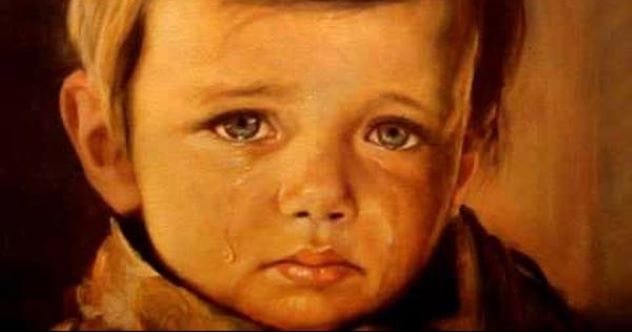Have you ever seen a painting that just gives you the creeps? The Crying Boy paintings are a series that did more than that—they sparked a legend of a terrifying curse. These portraits show a sad-looking young boy, often a ragamuffin, with big eyes and tears streaming down his face. They were designed to make you feel strong emotions, and they certainly did.
These prints became super popular in the UK and other places. Thousands of people bought them for their homes. But then, strange and scary things started happening wherever these paintings were. People whispered about a curse, one so evil it supposedly destroyed its subject, its creator, and the homes of anyone who owned a print. Of course, skeptics had other ideas, blaming it on urban legends or media hype. What’s the real story? Dive into these ten unsettling truths and decide for yourself what to believe about the Crying Boy paintings.
10. The Artist Used a Secret Name

The Crying Boy paintings were signed by Giovanni Bragolin. But guess what? Giovanni Bragolin didn’t actually exist. The real artist was a Spanish painter named Bruno Amadio. Sometimes, he also went by the name Franchot Seville. Amadio was a bit of a mystery man in the art world of the mid-1900s.
He painted over 60 portraits for his Crying Boy collection. This happened from the 1950s all the way through 1980. These paintings were printed over and over again and sold far and wide. They became incredibly popular, especially in the UK, where over 50,000 copies were sold.
The Crying Boy series was the only big success Amadio ever had as an artist. But it was a mixed blessing. The paintings showed horror, sadness, and the longing of innocent children. This made people wonder if Amadio was abusing the kids he painted. Some even said he scared them on purpose just to paint their terrified faces. A few people even compared Amadio to the devil!
9. The Boy in the Painting Was an Orphan
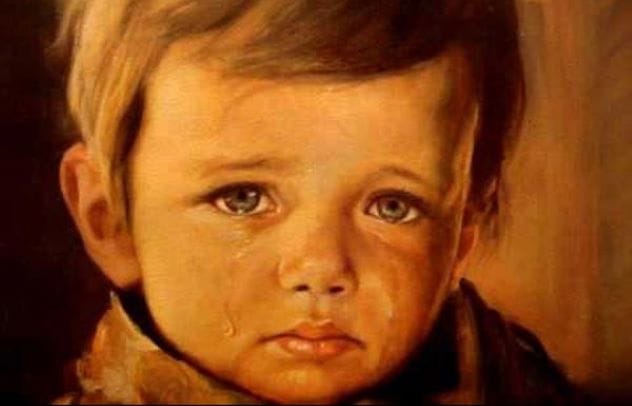
So, who was the boy in these famous paintings? According to Amadio, one of his subjects was a “little street urchin” he found in Madrid back in the 1960s. This young boy couldn’t speak and was an orphan. His sad face immediately caught the artist’s eye.
As Amadio started to paint the child, a Catholic priest came up to him. The priest gave him a serious warning. He said the boy, whose name was Don Bonillo, had run away after seeing his parents die in a fire.
Ever since that tragedy, mysterious fires would start wherever the boy went. This happened so often that people started calling him “Diablo,” which means “devil.” The priest told Amadio to stay away from the child. But the painter didn’t listen. Instead, he adopted the boy. He brought Don Bonillo home to live with him and continued to paint the Crying Boy series.
8. The Artist’s Studio Burned Down

The strange bond between the painter and his favorite model ended suddenly and in flames. Amadio’s art studio and his apartment mysteriously caught fire. He lost everything in the blaze. This disaster ruined Amadio.
He remembered the priest’s warning about Don Bonillo and the fires. Amadio blamed the boy for starting this fire. He kicked Don Bonillo out of his home and never saw him again.
Things got even worse for Amadio. Reports about the curse of the “Crying Boy” paintings started spreading all over Europe. His fame quickly turned into suspicion. People started to think he was a jinx. Nobody wanted to look at his paintings anymore, and certainly, no one wanted to pay him to paint something new.
7. The Subject’s Life Ended in Fire Too?

Sadly, Don Bonillo’s life seemed to end just as it began: with a terrible fire. In 1976, the police were called to a car crash on the outskirts of Barcelona. A car had crashed into a wall and then exploded into flames. When the officers got to the scene, they found the driver. He was burned so badly that they couldn’t recognize him. He was the only person in the car.
The police officers searched the car’s glove box, which had somehow survived the fire. Inside, they found a piece of a driver’s license. The name on the license identified the victim as Don Bonillo. For many people, the fiery way he died only made the Crying Boy curse seem more real and terrifying.
6. The Prints Mysteriously Survived Over 60 House Fires
The first reported house fire linked to the paintings happened in Rotherham in 1985. It was at the home of Ron and Mary Hall. The fire destroyed everything on the first floor of their house. But one item was untouched: a print of the Crying Boy hanging on their living room wall. During the fire, the painting fell off the wall and landed face down. Strangely, it was only slightly burned.
The fire department said the fire was caused by a chip pan (a deep frying pan) that got too hot and burst into flames. But the Halls were convinced the painting was cursed. They believed the painting, not the pan, was to blame for their home’s destruction.
The Halls weren’t the only ones with this experience. Many similar fires followed. Homes and even a pizza parlor supposedly fell victim to the curse. Even though these fires started from common causes, a Crying Boy painting was often left behind, nearly unharmed. The legend of the curse grew. People started saying it caused injuries and deaths. Some even reported accidents right after buying a print. Many others were horrified when they tried to burn the paintings themselves, only to find they wouldn’t catch fire.
5. Firefighters Couldn’t Explain Why the Paintings Didn’t Burn
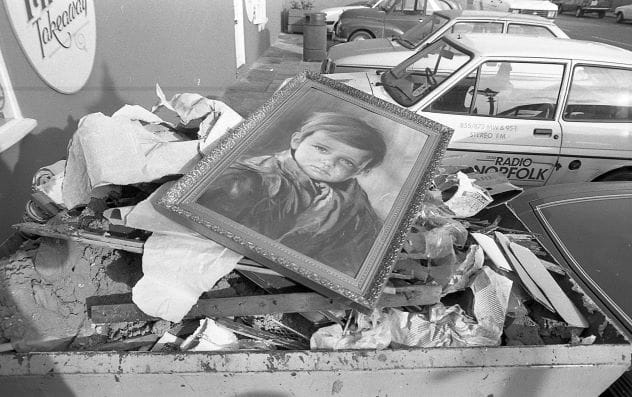
Fire investigators looked into these strange house fires. They found normal causes like discarded cigarettes, overheated chip pans, and bad electrical wiring. This led firefighters to believe the fires were due to human carelessness, not some supernatural curse. Alan Wilkinson, a fire station officer in Rotherham, personally recorded 50 fires where Crying Boy paintings survived the flames.
Wilkinson was skeptical about the curse, but he couldn’t explain how the artworks managed to survive the fires. His wife had her own idea. She often said, “I always say it’s the tears that put the fire out.”
Even though Wilkinson didn’t believe in the curse, he still seemed a bit superstitious. When he retired, someone tried to give him a framed print of the Crying Boy as a gift. He politely said no thanks. The panic spread so much that Chief Divisional Officer Mick Riley of the Yorkshire Fire Service had to make a public statement. He tried to debunk the curse, saying, “The reason why this picture has not always been destroyed in the fire is because it is printed on high-density hardboard, which is very difficult to ignite.” However, his explanation didn’t convince many people. Neither did the fact that the paintings often showed different children and were sometimes even by different artists.
4. A Tabloid Newspaper Article Ignited the Panic
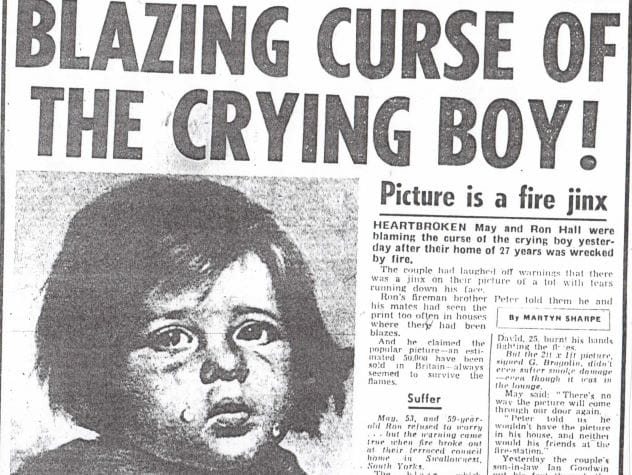
The Crying Boy paintings hit the headlines on September 4, 1985. It was the start of six weeks of intense news coverage. An article titled, “Blazing Curse of the Crying Boy,” appeared on page 13 of a British tabloid newspaper called The Sun. It told the scary story of Ron and Mary Hall, who had recently lost their home in a fire.
A follow-up article on September 5 brought even more terrifying tales. Readers wrote in, claiming they too were victims of the curse. These stories weren’t just about fires. People reported injuries and deaths. Some even described supernatural events. They said they saw the print swaying on the wall or that it reappeared after being destroyed.
The Sun also claimed that firefighters believed in the curse, even though the fire service said otherwise. Readers were hooked. Because so many people read The Sun, word about the “Crying Boy” curse spread like wildfire—pun intended! The newspaper kept publishing more articles, each one more sensational than the last. By the end of October, panic was at an all-time high. Many people looked to The Sun for answers.
3. Thousands of Paintings Were Burned in a Giant Bonfire
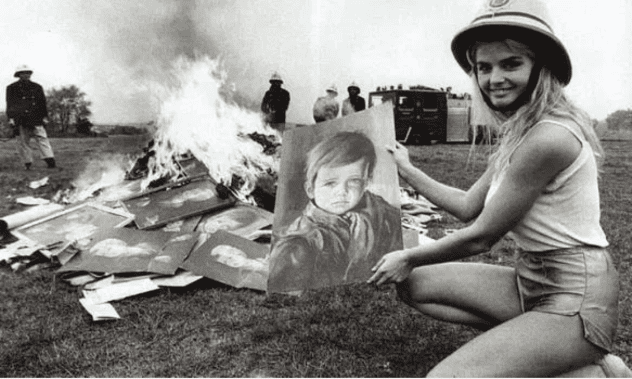
Kelvin MacKenzie, the editor of The Sun, is often called the “father of the Crying Boy curse.” He finally announced, “Enough is enough, folks. If you are worried about a Crying Boy picture hanging in YOUR home, send it to us immediately. We will destroy it for you—and that should see the back of any curse.”
Soon, The Sun’s office on Bouverie Street was flooded with Crying Boy paintings. They were “stacked twelve feet high in the newsroom, spilling out of cupboards, and entirely filling a little-used interview room.” In total, readers sent in about 2,500 copies of the print.
MacKenzie had to figure out how to get rid of all these paintings. He decided to burn them in a massive bonfire near the River Thames. This very public event took place on Halloween, with the fire brigade watching over it. The Sun published an article with the headline “Crying Flame!” It claimed the curse was finally broken. The article even included a reassuring quote from a police officer who was there: “I think there will be many people who can breathe a little easier now.”
2. The Painting Materials Might Hold a Clue
Even after the giant bonfire, talk of the curse didn’t completely disappear. Years later, British writer and comedian Steve Punt investigated the Crying Boy series for a BBC Radio 4 show called “Punt Pi.” Punt bought a Crying Boy picture. He said he was then “inexplicably delayed on his destination several times.” Finally, he tried to burn the print with Martin Shipp, a construction researcher.
The two men discovered something interesting: beyond the string holding it, the artwork didn’t really burn. Punt and Shipp thought that maybe a fire-retardant varnish was used on the paintings. This test also explained how the string holding the painting on the wall would burn first. This would cause the painting to fall face down on the floor, protecting it from the flames. Another investigation suggested that Amadio’s use of a compression board (a type of hardboard) could also be why the paintings were so hard to burn.
1. The Curse Became a Modern Urban Legend
Despite all the attempts to explain away the curse, many people continued to believe in it. The story of the Crying Boy paintings has grown into a full-blown urban legend. It’s even expanded to include paintings by different artists. For example, portraits by Scottish artist Anna Zinkeisen, which also feature crying children, have often been linked to the “Crying Boy” curse.
As recently as 2012, Season 3, Episode 4 of the TV show “Weird or What?” with William Shatner examined the legend of these paintings. Different online groups also popped up, like the Dutch “Crying Boy Fan Club,” though many have since disappeared. However, you can still find discussions about the curse on social media and forums. In February 2022, the Hanbury Arms Haunted Hotel & Museum posted that they had several Crying Boy paintings on display. This just goes to show that this spooky urban legend isn’t going away anytime soon.
Some people who believe in the supernatural argue that when an artist paints a portrait, a part of the person’s soul gets sealed onto the paper. There are many old stories about cursed paintings. Some tales even say that magicians could trap a person inside a portrait or tie their life to it. In the case of these Crying Boy paintings, the children’s faces show so much fear, sadness, and despair. Their wide-open eyes seem to reflect these emotions. It’s easy to see how looking at them could break your heart. So, it’s possible that the paintings held onto this negative energy. And maybe, through the paintings, these little subjects took revenge on anyone who hung their images at home. But that’s just a legend, right?
The Crying Boy paintings remain a fascinating subject. Whether you believe in a supernatural curse, a series of coincidences, or clever media hype, the story is undeniably chilling. The image of a tearful child, untouched by flames while everything around it burns, is a powerful one that continues to capture our imaginations.
What do you think about the Crying Boy curse? Do you own one of these prints, or do you know someone who does? Share your thoughts and stories in the comments below!


